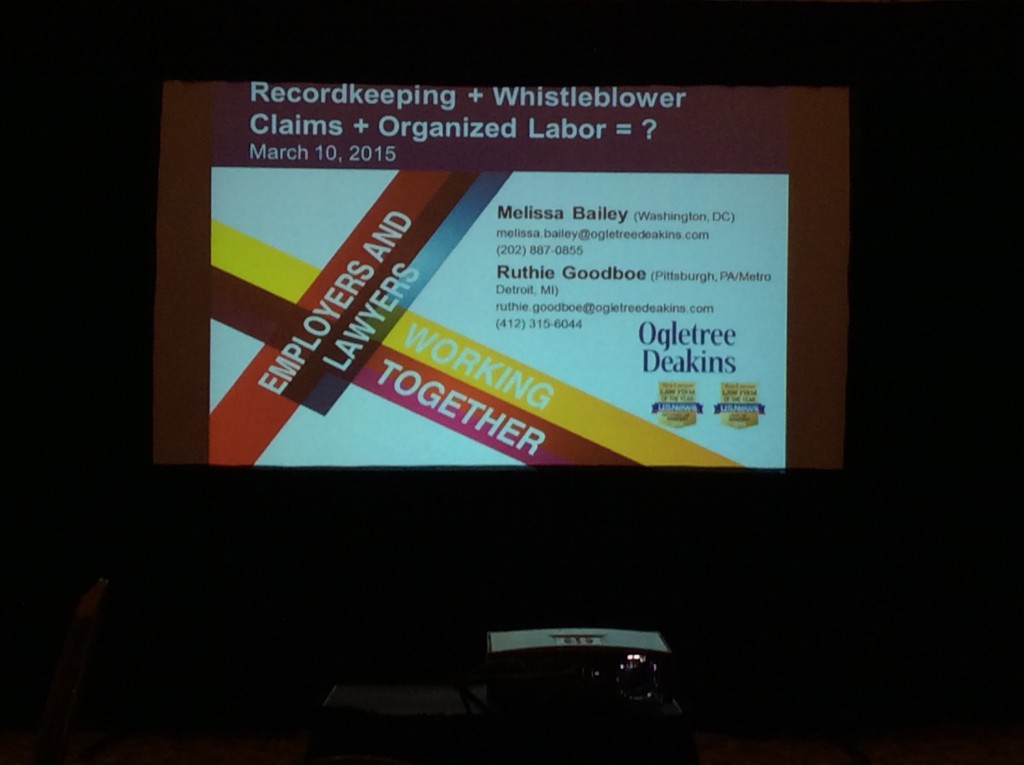The Intersection Between OSHA and Traditional Labor
At the FMI Asset Protection Conference on March 10, 20 we attended a session on OSHA recordkeeping, whistleblower complaints and union organizing, and how these things fit together. The speakers were:
Melissa Bailey, Shareholder, Ogletree, Deakins, Nash, Smoak & Stewart, P.C.
Ruthie Goodboe, Shareholder, Ogletree, Deakins, Nash, Smoak & Stewart, P.C.
Under the OSHA injury / illness reporting requirements effective 01/01/15, you are required to report to OSHA within 24 hours any fatality, hospitalization of one or more employees, amputations, or loss of an eye. This can be done by calling the OSHA 24-hour hotline. The unexpected change in these regulations is that OSHA is now making this information available to the general public. OSHA’s incentives for this appears to be public “shaming” of employers who are not in compliance with OSHA regulations.
There is concern that unions will use this information to allege “unsafe work conditions” to assist in their efforts in organizing unions at employers or when collectively bargaining.
There is also a pending proposal from OSHA on electronic recordkeeping. This would require employers with over 250 employees at a location to electronically file all OSHA 300 logs quarterly. This is a significantly hightened level of oversight as OSHA previously only obtained these logs when they did an onsite inspection. There is also potential for OSHA to look at the 250 employee enterprise wide, meaning if an employer has multiple locations with a small workforce at each location and their total employee count is over 250 employers could be faced with having to file OSHA reports for all these individual locations. This could be very logistically challenging for employers.
From an enforcement standpoint, this electronic reporting means OSHA will have much more information at their fingertips, which will undoubtedly lead to increased violations being issued. This also allows OSHA to compare records across multiple facilities, which could lead to a finding of “wilful” violations based on a pattern of conduct.
The expectation is that the unions will be mining this data to try and identify the injured parties so that they can reach out to them to gather additional information. Safety issues are one of the biggest hooks used by unions in organization campaigns. If you pair these new OSHA rules with the new “Ambush Election” rules around voting for unionization, employers have very limited time available to try and refute the messaging of the unions as the election is held within 21 days of filing the petition. Those new union election rules take effect in April but there are currently legal challenges to them.
Under current OSHA regulations, employers cannot retaliate against an employeee for reporting an injury. OSHA is looking to amend the record keeping regulation to clarify what is meant by “retaliation”. This would include things like “safety” pizza parties or raffles that employers often do as a reward for going a period of time without a reportable claim. OSHA will also be looking at management bonuses tied to safety performance out of concern that may lead to incentives to not report claims.
OSHA is also suggesting that mandatory drug testing of all employees post-injury could also be considered “retaliation” if there is no reason to suspect drug use. OSHA is viewing the threat of drug testing alone as potentially discouraging reporting. They also view penalties for late reporting of a claim to be a form of “retaliation”.
Another concern facing employers is that the NLRB (National Labor Relations Board) and OSHA have entered into a program where if someone wants to file a retaliatory claims outside the 30 day deadline provided under OSHA regulations, OSHA refers those people to NLRB to file the claim under their 6-month statute of limitations. This creates a much longer potential tail for these retaliation claims.


